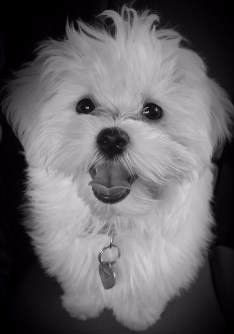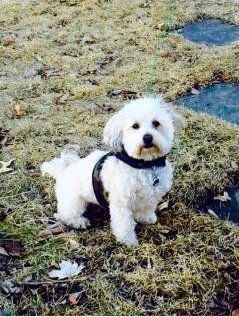Is a Maltipoo Hypoallergenic

Lexi, 18 weeks old
Photo courtesy of Christine Nelson
The Allergy and Asthma Foundation of America estimates that between 15 and 30% of people that have allergies are allergic to dogs. Those that are allergic may have a reaction to all dog breeds or just some. Many people who wish to have a dog but know that they are going to have an allergic reaction seek out dogs that have hair as opposed to fur since these breeds are often referred to as hypoallergenic dogs.
The question raised is if a Maltipoo, which is a hybrid cross between a purebred Maltese and a purebred Poodle (most often a toy sized Poodle, however sometimes a mini is used) is a hypoallergenic dog.
While many sources will simply give an answer of 'yes', the actual answer is not so black and white.
It is true Poodles, Maltese and Maltipoos
have hair and not fur, however the coat of any particular dog is not always the cause of allergies. When a person is allergic to a dog, it is not just the fur itself that causes the issue. Most people have a sensitivity to the dander that is shed. Dander is tiny pieces of dead skin that naturally scale off in a process of renewal.
The immune system reacts to the dog's dander in a highly sensitive way, as it sees it as a foreign substance similar to how it would react to a virus or bacteria. Some people may also have a response to proteins that are found in a dog's salvia; this can cause an allergic response if the dog licks that person or even if the dog's toys are handled.
The dander, which is referred to as the allergen, collects on a dog's coat. Both dogs that have fur and dogs like the Maltipoo that have hair do have dander. The surface layer of the skin is in a constant state of renewal. Tiny specks fall off and are replaced with new cells. This happens to all breeds (and people for that matter) at the same rate.
The difference in fur VS hair is that fur is often much thicker and will hold onto the dander; it gets trapped in the coat. With the Maltipoo, the hair is silky and soft, which allows the dander to fall off. When a person pets a dog or grooms
him, he/she will come into contact with the allergen that is present on the coat. So, with a Maltipoo, much less dander has collected on the coat and a person may have a lowered allergenic response when touching or handling the dog.
Additionally, breeds with fur often have heavy sheds.
This means that the fur (which is holding dander) sheds onto the furniture, flooring, beds and essentially all over the house. Some breeds shed so much that clumps of fur can be found everywhere. The Maltipoo, however, sheds very lightly which means that there will be less dead hairs in the house and on grooming tools, which in turn leads to less allergic responses.
While some refer to the Maltipoo (and its parents, the Poodle and Maltese) and non-shedders, this is not entirely accurate. The coat, as like the skin, is also in a constant state of renewal. Each hair of the Maltipoo's coat is either at growth, rest or fall-out. The difference is that this happens at a much slower rate than dogs with fur.
Therefore, all dogs regardless of type of coat have dander and are, in turn, able to cause an allergic reaction in people who have sensitivity to the dander. The Maltipoo or any other breed with hair is not 100% hypoallergenic. It is more accurate to say that the Maltipoo is low-allergenic.
With hair that only lightly sheds and with a silky texture that does not trap much of the dander, this hybrid
dog will typically cause less severe reactions in those that are allergic to dogs.
It should be noted that since dander is indeed present on the Maltipoo, if it is not held in by the coat it will then be present on the dog's bedding, other resting areas and on grooming tools such as brushes and combs. It can also be present to some degree in the air; and these particles can remain airborne for quite some times.
In conclusion, the Maltipoo can be a hypoallergenic dog for those that do well with less dander as opposed to high levels.
It is always best to test a person's reaction to any particular dog breed before obtaining a new puppy. Potential owners should handle the puppy for 20 minutes, several times before a decision is made as to whether or not the dog is capable of causing a reaction. It is best to do this indoors since if done outside, air currents can displace the dander and not offer a realistic response.
For those that have already obtained a Maltipoo assuming that the dog was hypoallergenic but have found that they are actually allergic to the dog, there are some things that you can do:
1) It is recommended to see an allergist to run tests to see exactly what you are allergic to. In some cases, owners have found that they are not having allergies
in response to their Maltipoo, but rather to pollen or even dust.
2) In many cases, an OTC antihistamine can help though you'll want to speak with your doctor regarding long term use.
-267x263.dm.edit_uJC5Mj-1920w.jpg)
Snow White, 5 months old
Photo courtesy of Cameron Diaz
3) If possible, another person in the household that is not allergic to the dog should be responsible for grooming and other tasks that require close contact with the Maltipoo.
4) Whenever possible, the Maltipoo should be brushed and groomed outside.
5) The person who is allergic to the dog should not handle the food
dishes, toys or other belongings of the Maltipoo.
6) The Maltipoo should be kept off sofas, chairs, beds and other furniture where the person with the allergy will be sitting, resting or sleeping. Keeping the puppy or dog out of bedrooms and keeping the doors to those rooms closed can help quite a bit.
7) Since the allergen (dander) will be present in the air, running a central AC or fan unit using HEPA (High-efficiency particulate arrestance) filters can help trap these fine particles and remove them. You will want to use filters that are rated as 'best' with a high MERV rating. There are also portable air cleaners that use HEPA technology to remove fine allergen particles.
Summary -
While just about all breeds with hair have been deemed hypoallergenic, they all produce dander and can therefore cause an allergic reaction. The Maltipoo, with its silky soft coat of hair is indeed going to cause much fewer problems that a dog with a thick coat of fur. Even so, if you are thinking about bringing this amazing hybrid dog into your home and are unsure of how you will react, it is best to test this by being in contact with the puppy several times in an enclosed, indoor area to see how your body responds. Any symptoms of allergies, including a swelling of the eyes, runny nose, itchy eyes, or skin reactions should not be ignored and are signs that there is enough of an allergen present to cause issues.
Things To Do Now
Become a Free Member- (If you are not already a Member) so that you'll receive a friendly reminder we add new pages of information to this site. You can also suggest a topic for us to write about or ask a question about your Maltipoo.
See top recommended supplies
for optimal health, comfort, safety, and happiness. Covers grooming items, beds, playpens, separation anxiety aids, toys, and more.
See what is inside The PetMaltipoo eBook
- The most comprehensive Maltipoo care book that exists. This is a "must-have" book for all Maltipoo owners.


